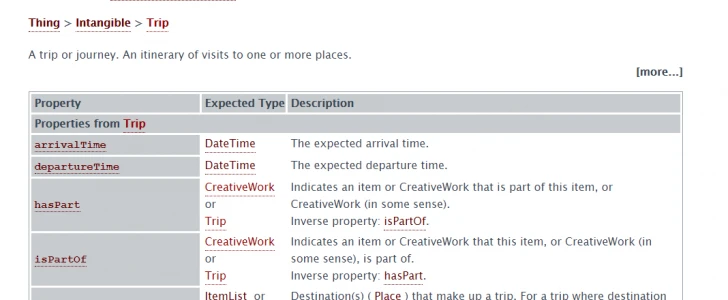What is structured data, and why use it for SEO
Published by Incomedia in Guides and Tips · Friday 19 Jun 2020
We do it every day, even several times a day: we open a browser window and ask Google to answer a question, find information, or simply satisfy our curiosity.








Whether it's about work or our personal lives, we always expect a quick, accurate answer, and to its credit, Google does its best to satisfy us.
But how does it do it? How does it understand what it is we're really looking for?
It's not a trivial question: understanding how the most widely used search engine in the world works actually means learning how to build our websites in a way that allows them to be indexed better, and therefore to position ourselves better, perhaps even on the first page of search results!
In this guide, we'll discuss how Google tries to understand natural language, and how we can help it along by using structured data. We'll gain a better understanding of what it is, how to use it, and most importantly, what advantages it can bring us.
From key words to the search intent
Let's start with an example: let's say you wanted to do a search, and you typed in “Mercury”.
If you think the search engine simply searches for pages that match the key words, I'm sorry to say that things have changed. Google tries to “understand” what we write, ever since the 2013 and 2015 updates to its algorithms introduced natural language analysis and artificial intelligence: now, semantics have become a key factor in Google searches.
Let's look at our example again. Google isn't simply searching for files that contain the word “Mercury". Instead, it tries to understand our search intent: are we interested in the planet or in the element?
As humans, we can resolve these kinds of ambiguities more or less automatically. It's a little more complicated for search engines, however. Google strives to overcome linguistic ambiguities and understand our requests, as well as the contents presented on web pages, using context clues.
But how does a search engine know what the context is? By reading metadata.
Metadata: data that describes data
Simply defined, metadata is data that describes other data.
This is not a new concept: for example, librarians use metadata to categorize books in order to be able to find them faster. For example:

“Title,” “Author”, “Year", and “Publishing House” are the metadata that serve to categorize the data.
Metadata needs to follow a classification system that everyone understands in order to work. In other words, there needs to be a set of rules, a standard that everyone follows in order for the system to be successful.
When it comes to search engines, metadata is called structured data, and they are implemented according to a set of rules called Schema.org.
What is structured data?
Structured data is meta information that has to be inserted into the pages’ HTML code in order to provide additional data which is used by search engines to categorize and better understand their contents.
This data is said to be “structured” because, as mentioned, it is organized according to the Schema.org vocabulary, a chart which allows entities and relationships to be defined by transforming content into data.
In practice, correctly inserting this metadata and following Schema.org's syntax rules allows Google to understand the meaning of the information available, and deliver more relevant search results to users.
As Google explains in its own developer guide: You can help us by providing explicit clues about the meaning of a page to Google by including structured data on the page [...] Google uses structured data that it finds on the web to understand the content of the page [...]”.
What is Schema.org?
Let's take a moment to look more closely at Schema.org. As mentioned above, it's a vocabulary of structured data (markups) which defines entities, actions, and relationships on the Internet.
In practice, the Schema.org vocabulary includes formats for structuring data relating to all kinds of people, places, and things on the web: the complete list of elements that the Schema markups can define is available on the Schema.org website.
For example, Schema.org has a lexicon for travel, which can define departure dates, arrival dates, and a description of the offers.

Schema.org was created in 2011, as a collaboration between Google, Microsoft, Yahoo, and Yandex. It's an open-source project that evolves over time thanks to the collaborative work of its community of followers.
How to insert structured data
3 different languages can be used to insert the markup defined by Schema.org into a page's HTML code:
- RDFa
- Microdata
- JSON-LD
The format which Google recommends, and which is also the most widely used, is JSON-LD, which uses JavaScript to encode structured data at the beginning of the page, in a manner that's completely independent from the content present on that page.
Google also makes a tool available which allows you to generate and implement Schema for your pages: the Google Structured Data Markup Helper.
You can also use the Google Structured Data Testing Tool to test whether the markup you've inserted is correct.
With WebSite X5, you don't need to rely on any external programs or extensions: the software makes it easy for you to manage the implementation of the most common structured data and automatically inserts the necessary JSON-LD code.
How Google uses structured data
As we explained above, Google is fairly good at its job, and normally, the Googlebot (the spider that scans the web) is able to recognize the entities present on a page.
So why use structured data?
- Because using a shared vocabulary means we speak the same language: the search engine no longer needs to “try to interpret” your page, and risk making mistakes, while you can be certain that the information presented in your web pages is received as correctly as possible.
- Because Google uses structured data not only to better understand the contents of a page, but also to create elements like rich snippets, rich cards, and knowledge graphs, which it displays in the SERP.
Snippets and Rich Snippets
When we perform a search, Google shows us a page with a list of results: this page, as you may know, is called the SERP Search Engine Results Page.)
Each result within the SERP is made up of a title and a description: this description is called a snippet.

The snippet is very important:
- in general, it contains key words which help determine a website's relevance for the search engine;
- if it's well-written, it may convince the reader to click the link and choose that page instead of other pages displayed in the SERP.
In general, Google extracts the snippet from the Description metatag inserted in the pager's HEAD. We’ve discussed this topic in more detail in another post: What Meta Descriptions are and how to use them for SEO
Meanwhile, Rich Snippets refer to snippets enriched with graphic elements, which increases visibility and encourages user interaction. The search engine actually extracts this additional information from the structured data.
Let's take a look at a few examples.
Structured data for Recipes can enrich the snippet with stars and photos, as well as information about cooking time and calorie counts.

Meanwhile, structured data for Products can enrich the snippet with prices, in-store availability, technical specifications, and review stars.

Using the structured data provided by Schema.org for events allows the dates and locations of different events to be displayed in the snippet as well.

So in general, rich snippets are more visually complete and attractive than traditional snippets, meaning that statistically, users are more likely to click on the links they display. This results in an overall improvement of the CTR (Click Through Rate), which is the number of clicks compared to the number of times Google displays the snippet. If the snippet is displayed 100 times, and 50 people click on it rather than 10, that's quite an improvement, wouldn't you say?
as we mentioned earlier, Google uses structured data to enrich its results with additional information and multimedia elements, and it may display the results in different ways. In general, a search result's appearance may change over time, depending on the device used (desktop computer or mobile phone), the country, and many other factors: Google tries to display the result in the way it believes is most useful for the user.
This means Google may display carousels.

It may decide to display an artist's songs as a series of rich cards:

Or it may decide to group all of the page's structured data to create an info sheet:

The point is that Schema.org's vocabulary of structured data forms the basis for all of these solutions, which have the indisputable advantage of drawing users’ attention: and therefore their clicks.
As we've seen, more visibility means more clicks, which results in more traffic: which is what any site owner is aiming for.
Structured data and voice searches
Adding structured data is also useful if you're thinking about the near future, in which voice search will continue to play an ever-greater role.
According to forecasts by Juniper Research, the use of voice assistants is set to triple, from 2.5 billion digital voice assistants in use in 2018 to over 8 billion by 2023.
Voice assistants like Google Home and Alexa can perform different kinds of tasks, like turning on the lights in a house, for example, or playing a song for you while you're driving: these actions rely on voice commands.
Voice assistants can also answer our questions when we want to look something up online: this kind of action is called a voice search.
According to Google, a good 27% of the world's population uses the voice search feature on their smartphones.
Of course, all of this will also have an increasingly important impact on SEO.
When we ask our voice assistant, “Hey Google/Alexa, find me the best restaurant in Turin,” the voice will respond with a single recommendation. Many studies on voice searches, including a 2019 study by SEMrush, shows that voice assistants rely heavily on structured data to select their recommendations, and that most of the answers transmitted via voice search use some form of Schema.
This means that the more structured data is used, the more pages will be ready for this new search frontier, and voice assistants will be able to interact with and transmit the information they contain.
Conclusions
To sum up, we discussed how Google continues to strive to “understand” natural language to identify the search intent that guides our use of the search engine.
In order to help it, we can try to “speak” a language that uses a shared vocabulary: this language relies on the use of structured data based on the Schema.org vocabulary.
Thanks to structured data, Google is not only able to better manage information and display more relevant answers to search queries, it also uses this data to enrich the snippets shown on the SERP with elements like stars, images, prices, etc.
Rich snippets draw users’ attention and are statistically proven to lead to an increased CTR. More clicks ultimately translate into more traffic to your website.
Finally, structured data also forms the basis for voice searches: voice assistants tend to use them to formulate their responses to our questions.
There's also another element to consider. Many sites still do not use these tools, forcing search engines’ crawlers to interpret them in a way that can be difficult and lead to mistakes. Providing structured data therefore makes crawlers’ work easier, allowing them to function more effectively. This could be the leg up that gives you an advantage over your competition.


